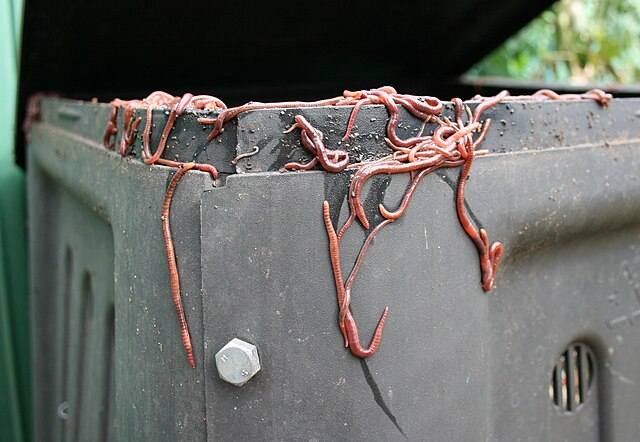Let’s talk compost: vermicompost to be specific. What’s that? Well, technically it’s worm poop and it’s amazing stuff: full of humus and microbes to inoculate garden soil or revitalize house plants. Worm composting systems deliver more than a top-notch fertilizer; they make it possible to compost kitchen scraps without a large outdoor compost bin–perfect for apartments or small households, although you can create a megasized wormtopia too, if that’s your thing. As long as the temperature stays between 50 and 85 degrees, worm bins can live inside or outside, and with proper management, they won’t produce funky smells. Worms make very well-behaved pets.

Worm composters are pretty easy to set up. Here are the components:
1. The container. There are different routes here, depending on your size needs and DIY ambitions. Size will depend on the amount of food scraps you’re looking to compost which affects the number of worms you’ll want and the surface area they need (like regular composting systems, vermicomposting is an aerobic process so good air flow is important). Mary Appelhoff’s easy to follow book, Worms Eat My Garbage, shows you how to do the size calculation and add other necessary features, like drainage holes. If figuring out worm floor space isn’t for you, there are premade worm farms available like the Sun Leaves Worm Farm, a cushy worm condo with stackable trays that really simplifies harvesting the worm castings (another fancy word for worm poop) and castings tea, a potent liquid fertilizer. Just add the trays on top as the worms finish eating and they’ll move up to look for more grub, leaving the compost ready for use.
2. Bedding. Worms enjoy chilling in a variety of materials, which they also eat and convert to compost. The bedding also gives you a place to bury your food scraps so the worms can eat peacefully in the dark. Moist coco coir is a great option that stays well-aerated, you can recycle shredded cardboard or paper, or use a combination of materials.

3. WORMS! Nothing against earthworms but not any old garden worm will do for vermicomposters. The best species to use is Eisenia fetida, alias: the Red Wriggler. You can find them at bait shops but it’s best to start with at least a pound of them (that’s roughly 1,000 worms!) so ordering from a supplier may be more economical. Coming soon: pre-order cards will be available in the store–just mail them in and the worms will be shipped directly to you.
4. Food scraps. Red wrigglers will eat a variety of kitchen and garden waste (with a few exceptions like fatty meat, dairy and citrus peels). There is flexibility with feeding scheduling but again, managing the amount of food you give them takes a little attention because you don’t want a lot of food just hanging out or worms going hungry. Once you figure out approximately how much worm food you generate on a weekly basis, you can be consistent in meeting your worms’ needs.
So if you thought you couldn’t have a home composting system or if you’ve always been secretly fascinated by worms’ reproductive cycle (it’s pretty bizarre), consider vermicomposting. Come by the store if you have questions about getting your worm farm up and running!
By Martha Morris

George says
Thanks for sharing a wonderful article on vermicomposting, did happen to view an interesting site, http://www.happyworms.ca , wanted to share !
Marty Roddy says
I love worms. I have used them for years.
A pound of worms will turn a pound of kitchen scraps into beautiful compost almost daily and the worms will also turn themselves into 2-3 or more pounds of worms to fill additional worms bins or for fishing/sharing or addition to garden compost piles.
They don’t do very well in a Virginia garden- at least I haven’t had luck with them(red wigglers).
Maybe i will ALSO some earthworms so I can add to the garden.
https://twitter.com/martyroddy
http://www.cheapskategarden.wordpress.com
Love to see a talk by worm / vermicompost expert.